
views
Choosing and Organizing Information
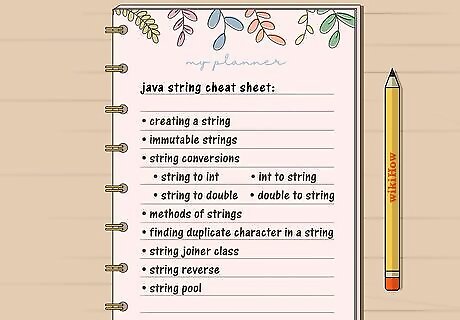
Make a list of information you need to know for the test. Before planning your cheat sheet, review your study materials to find what you have to know for the test. During your review, make a list of all the information that will be on the test. Go back through your notes and textbooks and find things you underlined or highlighted. This means it’s important information that will probably be on the test. If your teacher did a review session or gave you a review sheet, pay attention to what you have to know from these aids. For example, if your teacher said all the vocabulary words in a chapter will be on the test, list all those words and their definitions.
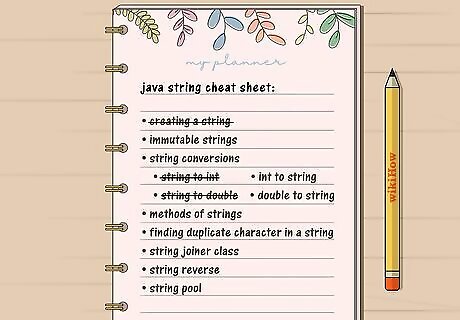
Cross out things you already know to save room. You’ll have limited space on your cheat sheet, so make the most of all your room. If there is information you already know well, don’t bother putting it on the sheet. Instead, use that room for something you don’t know as well. Go through your review list and cross out everything you knew already. Then plan on putting the remaining information into your sheet. For a math test, you might be very good at finding the area of a circle, but always forget the formula for circumference. In this case, cross out the formula for area of a circle but keep the formula for circumference.
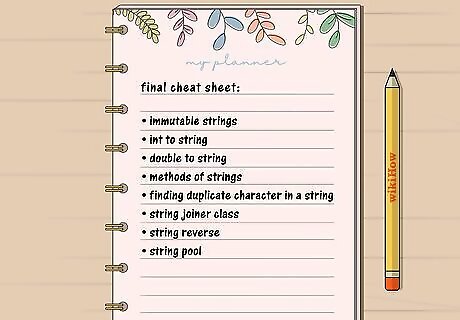
Make a final list of things you need on your cheat sheet. Finally, after reviewing your materials and crossing out what you already know, you’re left with all the test subjects that you aren’t as confident on. Write all of this information down to prepare for making your cheat sheet. As an added bonus, reviewing all of this material will help you retain information. The process of making your cheat sheet is just like studying.
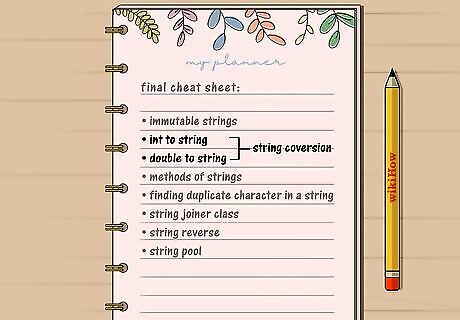
Group similar information into sections. Once you've identified all the information you need for your cheat sheet, organize that information into categories. You should group together similar pieces of information so the cheat sheet is easy to read. Scan the items on your list and see what information groups together. Then make different categories for this information. The best way to group information depends on what kind of test you're taking. On a history test, for example, you might have to know vocabulary words, important people, and important dates. Make these 3 separate categories and put the correct information into each group. If you're preparing for a chemistry test, a better organization might be formulas, key terms, and element names.

Study like you would normally. Using a reference sheet for a test doesn’t mean you don’t have to study. It’s only an aid for the knowledge you already have. After making your reference sheet, study for the test like you would normally. That way, you will only need the cheat sheet to jog your memory and find the information you need quickly. Don’t rely on the cheat sheet completely because you could run out of time on the test. You’ll spend all your time trying to find answers instead of doing the test. Studying in combination with using a cheat sheet sets you up for the most success. Try to start studying around 2 weeks before your exam date.
Constructing Your Sheet
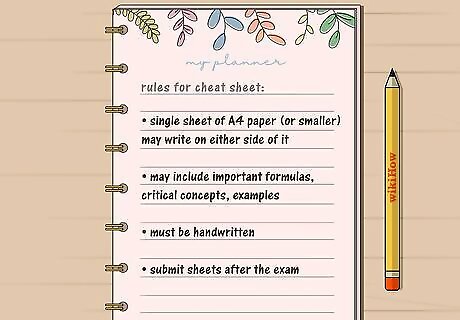
Follow all the teacher’s rules for the cheat sheet. If your teacher set strict rules for how you can make your sheet, follow them carefully. If you break any rules, your teacher may not allow you to use the sheet and all your hard work will be for nothing. Pay attention to the size your teacher allows. Your teacher might say you can use a full sheet of paper, or they may only allow an index card. Also remember if your teacher says you can use the front and back of the sheet, or just one side. Check if you can type or handwrite the sheet. If you’re unsure about any of the specifications, double check with your teacher.
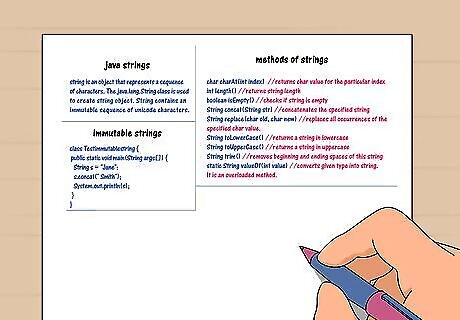
Divide the sheet into neat sections. Don’t make your cheat sheet a jumbled mess of writing. Break it down neatly into columns and sections that you can easily skim. These sections might be divided differently based on what type of test you have. On a history test, for example, your headings could be, “American Revolution,” “Constitution,” and “Vocabulary Words.” On a math test, the sections might be “Area of a Circle,” “Quadratic Equation,” and “Volume.” In either case, you can quickly find the section you need. If you have room, draw lines between sections so you can quickly see where sections start and end.
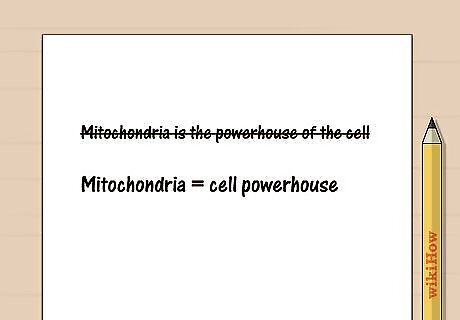
Abbreviate your writing to save room. Avoid the temptation to write every single word from your notes on the sheet. Work on using short words, phrases, and abbreviations on your sheet so you can put the most information into a small space. That way, you won't spend too much time reading your notes on the test. For example, don’t fully write out “Mitochondria is the powerhouse of the cell.” Instead, write “Mitochondria = cell powerhouse.” This gives you all the necessary information with less space. The same logic works for a math exam. For a math test, important information would be formulas and when to use them. Add this information in the quickest way possible. The formula itself and a few words on when to use it tells you all you need to know.
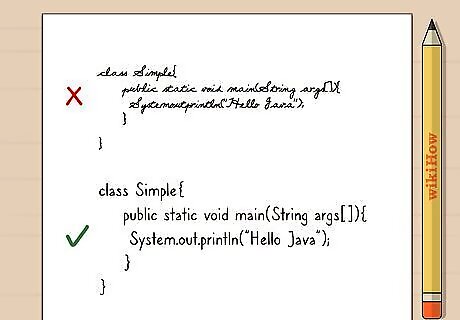
Write small but legibly. Fitting all the information on your cheat sheet is a balancing act between writing small to save space, but still big enough that you can read the information. Try doing an experiment first. Write a few sentences as small as you can. Then see if you can quickly skim those sentences without slowing down or bringing the sheet closer to your eyes. If you can, this is a good size to use. If not, make the writing a little bigger. Use an extra-fine ballpoint pen if you have trouble writing small. Don’t use gel pens, because the ink will bleed together and you won’t be able to read your handwriting. Don’t use a pencil or erasable pen. Your writing will smudge. If you’re allowed to type your cheat sheet, making the font small is much easier. Remember that you still have to read the words, though, so don’t make the font too small to see.
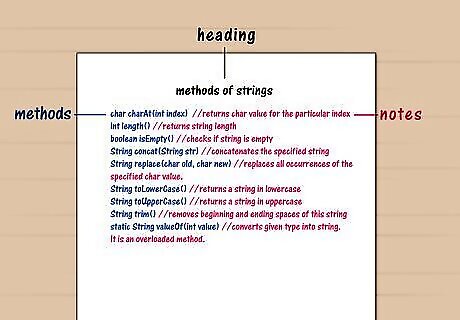
Color-code your sheet so you can find information easily. Different colors will make your cheat sheet even easier to skim. Try writing different sections or headings in different colored ink. If you’re typing your cheat sheet, switching the font color is even easier. Keep track of sections by using a color code on top of the sheet. For example, you could use blue for vocabulary words, red for important people, and black for important dates. Use ink that you can read easily. Light colors like pink might be hard to see, especially if you’re reading quickly. If you don't have different colored pens, you could also use colored highlighters to distinguish different sections from each other.
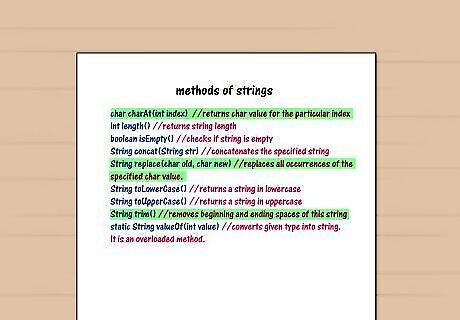
Underline or highlight important terms in a different color. Another trick for making your cheat sheet easy to read is marking important information by underlining it with a different color or highlighting it. This distinguishes key terms, phrases, formulas, and people so you can quickly scan the page for the information you need. On a vocabulary test, for example, it might be hard to distinguish between the key terms and their definitions if there is a lot of writing on the page. Make the job easier by underlining the terms in red ink. That way, you can easily skim the page to find the key terms.

Add more information if you have room leftover. Use all the available space on your cheat sheet. After giving priority to information you don’t know, you might still have room leftover. In this case, fill up the remaining room. Sort the remaining information and see what you definitely know very well and what you you know fairly well, but might forget or get confused on. Then you have a comprehensive cheat sheet with all the information you need to ace the test.




















Comments
0 comment